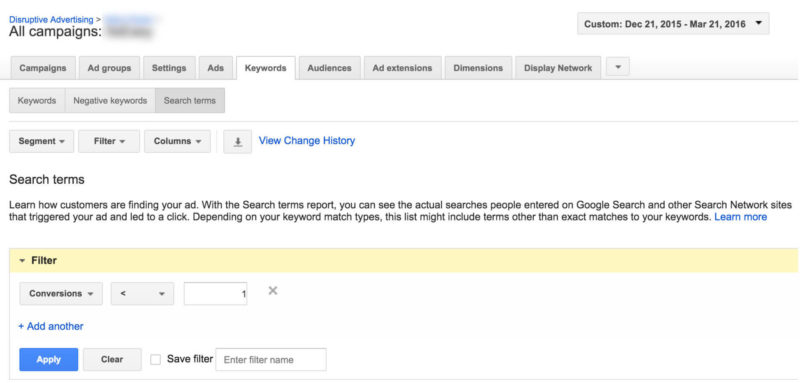From waste to win: watch how a simple change affects AdWords performance
Wasted ad spend can indicate issues with your AdWords account. Fortunately, as Jacob Baadsgaard reminds us, it's also under your control.
Over the past two years, we’ve audited more than 2,000 AdWords accounts at Disruptive Advertising.
I’ve written at length elsewhere about what we learned from all of these audits, but in this article, I want to explain how you can use our conclusions to directly improve account performance.
To begin, let’s take a look at where most ad spend goes wrong. Then, I’ll show you how controlling wasted ad spend directly improves account performance. Lastly, I’ll explain how to use your own account data to access the full potential of your AdWords budget.
Ready? Let’s get started.
Where’s your budget really going?
Ideally, your AdWords budget should be buying you clicks that are likely to convert — that’s the point, right?
Since paid search advertising is intent-based marketing, your ads should show up for internet searches that indicate a strong purchase intent. In other words, you want to be seen when people are looking to buy what you have to sell.
The question is, how do you know if your ads are showing up for high-intent searches?
Well, it’s fairly easy: just look at your Search Terms report. The Search Term report lets you see exactly what searches triggered your ad and how many impressions, clicks and conversions each search term produced.
If your campaigns are running effectively, your ads should show up when people are searching for what you have to offer. As a result, when they click on your ad, they should be taken to a landing page that meets their needs and convert.
In concept, it sounds great. In practice, though, it rarely works out that smoothly.
Across thousands of AdWords accounts, we discovered that the median AdWords account wastes 76 percent of its budget on search terms that never convert. That means the average AdWords account is wasting 76 percent of its budget.
Now, to be fair, when a company spends more on AdWords, they do get more productive spend:
But, even looking at total ad spend across all accounts, 61 percent of ad spend is still wasted on the wrong search terms.
Fixing the problem
Fortunately, wasted ad spend is a very easy problem to fix. You control your keywords, which gives you control of your search terms. So, if a search term isn’t converting, you can stop paying for it!
After discovering how much ad spend is wasted, we made eliminating wasted ad spend a key part of how we manage our clients’ AdWords accounts. The results have been astonishing.
Check out the charts above. On the left, you can see how much is spent on each term and how many conversions that search term produces. On the right, you can see how that translates into total ad spend and total conversions.
As our clients stop wasting money on the wrong search terms, spend drops and conversions spike.
And the improvement isn’t linear… it’s exponential. In most cases, each 10-percent decrease in wasted ad spend (e.g., 70 percent to 60 percent) decreased the cost per conversion by 30 to 60 percent.
That’s each 10-percent decrease.
So, if you’re wasting 76 percent of your ad budget today, and you drop that number to 66 percent, your cost per conversion could drop by as much as 60 percent. And if you get your account down to 56 percent wasted ad spend, your cost per conversion could drop another 60 percent. And so on… and so on… and so on…
For example, as one client’s wasted ad spend dropped from 91 percent to 68 percent, their cost per conversion dropped from $160.38 to $38.58!
And it all happened in a matter of weeks.
“But Jake,” you might ask, “what about sales? It doesn’t mean much if all of those cheap conversions don’t turn into sales!”
Remember, this approach doesn’t actually change which terms we bid on, it just focuses the budget on what’s working. As a result, our clients simply got exponentially better results from their productive keywords and search terms.
And it showed in their sales numbers, as well. While not all of our clients report their exact sales numbers back to us, we regularly see results like 300 to 500 percent more sales or 25 to 65 percent lower costs per sale using this approach.
How to take control of your wasted ad spend
Now, at this point, you’re probably thinking…
Fortunately, tightening up your Search Terms report is fairly straightforward. It takes some time and commitment, but the results are well worth the effort.
Get your conversion tracking working
To begin with, you’ll want to make sure that you have great conversion tracking in place.
In our audits, we found that although 58 percent of AdWords accounts have some level of conversion tracking in place, only 29 percent actually track conversions effectively. It’s not enough to simply track form fills. You need to track every type of conversion that comes from your ads: phone calls, chat messages, purchases… everything!
This is actually a lot easier than it sounds; you just have to take the time to do it.
Hopefully, if you’re a Search Engine Land regular, this should already be done. However, if you know you’ve got holes in your tracking, now’s the time to take care of them. Stop, go get your tracking set up (For help, click here for AdWords and here for Google Analytics) and come back when you’re done.
Pull your Search Terms report
Once you’ve got a few months of quality conversion data in your account, you can see where your budget is really going.
It’s important to run your analysis on at least a month (preferably three to six months) of data. On any given day, or even week, there can be a lot of variability in which search terms produce results, so you need to look at a large window of data to get a good feel for how things are working.
To see where your budget is going, open AdWords and go to the Keywords tab. Make sure your date range is set appropriately, and click on “Search Terms.” From there, you can see how much ad spend each search term consumed and how many impressions, clicks and conversions it generated.
This is helpful, but to see how much of your ad spend was wasted, you’ll need to click the Filter drop-down menu and “Create filter” for “Conversions < 1” as follows:
Scroll down to the very bottom of your filtered list, and look at the “Total – all filtered search terms” row. The number in the “Cost” column is how much you spent on search terms that never produced a single conversion.
Divide that number by the total amount you spent on all search terms, multiply by 100 percent, and you’ve got your percentage of wasted ad spend.
Discard the waste
Now comes the fun part: fixing your account.
In my experience, the Search Terms report usually evokes one of two reactions:
1. “What in the world?”
For some accounts, the problems are so extensive that there seems to be little rhyme or reason to the Search Terms report. This is usually a sign of poor campaign structure.
If your Search Terms report leaves you wondering, “Why have I been paying for that query?” or “What does this search term have to do with my campaign?,” you probably need to consider rebuilding your account from the ground up.
Create new, highly focused campaigns around the keywords and search terms that are working, and then let things run. This alone will improve your campaign performance, but you’ll want to run this same report again in a few months when your account is running properly.
2. “Well, that’s interesting.”
On the other hand, if your account is working decently, you should be able to use this report to identify a variety of specific problems.
For example, if no one is converting on a particular search term that seems highly relevant to your business, it may be time to revise your advertising strategy for that term. Maybe that term needs a dedicated ad or landing page. Maybe you just need to test different ad copy to find something that works. Maybe the term isn’t as relevant as you thought it was.
Alternatively, you may find search terms that seem to occur rarely, but they all share something in common. Together, they indicate a major flaw in your keyword strategy that needs to be fixed.
Regardless of the specifics, looking at where your ad spend is being wasted will give you a ton of insight into how to improve campaign performance.
What we shoot for
As a general rule, we usually shoot for < 40 percent wasted ad spend in the accounts that we manage. This keeps your budget highly productive, while giving you room to test out new keywords.
However, even getting your wasted ad spend down from 76 percent to 50 percent will have a profound effect on your campaign performance, so don’t despair if that < 40 percent mark seems unattainable.
Conclusion
Wasted ad spend is a huge indicator of the health of your AdWords account. Fortunately, wasted ad spend is also a metric that is almost entirely under your control.
So, if you need to cut cost-per-conversion and boost sales, take a hard look at your Search Terms report. This critical report offers the vital information you need to eliminate waste and dramatically improve campaign performance.
Try it out and let me know what happens!
Opinions expressed in this article are those of the guest author and not necessarily Search Engine Land. Staff authors are listed here.
Related stories
New on Search Engine Land







